5 Reasons You Don’t Want Nandina in Your Yard
If you walk around my neighborhood in San Antonio, TX, you’ll see Nandina domestica in almost every yard. It must have been on sale at the nursery when our homes built! We had recently removed a number of Nandina shrubs after learning more about them.
If you want to learn more about non-native invasive plants like Nandina, be sure to download my FREE 10 Invasive Plants to Avoid PDF!
What Does Nandina Look Like?
1. Bamboo like stems
Nandina is a tall leafy shrub that can grow 6-8 feet tall. Each shrub is made up of numerous narrow stems that resemble bamboo, and give it some of its common names of “Heavenly Bamboo” and “Sacred Bamboo” even though it is not actually bamboo.
2. Evergreen leaves
Its leaves are evergreen in the winter, which has made it such a popular landscape plant. The green leaves tend to have a touch of red in the winter as well.
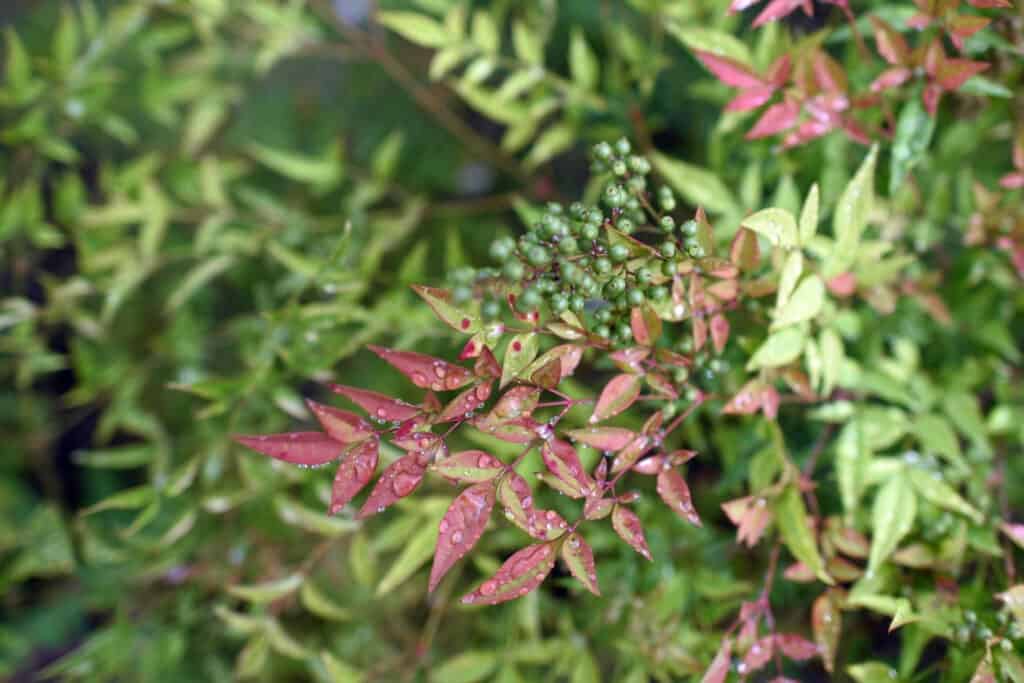
3. Red berries in winter
Nandina also produces red berries throughout the winter. Apparently if you have a group of plants growing together they are more likely to produce berries than a single plant.
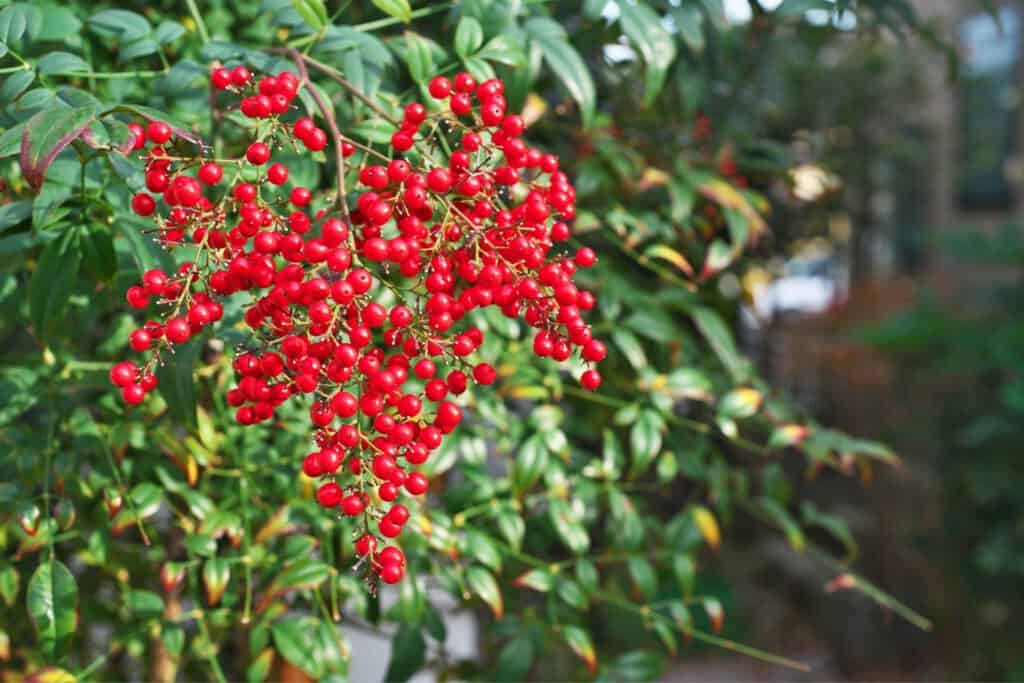
Where Will You Find It in the US?
Even today, Nandina is readily available at nurseries throughout the southern US, despite being designated as an invasive species.
According to the USDA Forest Service, you can find Nandina growing in forested areas in the following states:
- Alabama
- Florida
- Georgia
- Louisiana
- Mississippi
- North Carolina
- South Carolina
- Tennessee
- Texas
- Virginia
Where is Nandina Native to?
Nandina was brought to the US from Asia in the early 1800s. It is native to China, Japan and India.
Like many plants imported from other parts of the world, it was brought to the US for its ornamental qualities such as its berries and evergreen leaves.
Download the Free Invasive Plants PDF
Want to learn about non-native plants that have become invasive in parts of the United States? Download this FREE PDF to start. It contains a photo and information on 10 problematic plants that are still being sold by nurseries.
These plants escape cultivation in our yards and spread to natural areas, often crowding out native species and forming monocultures.
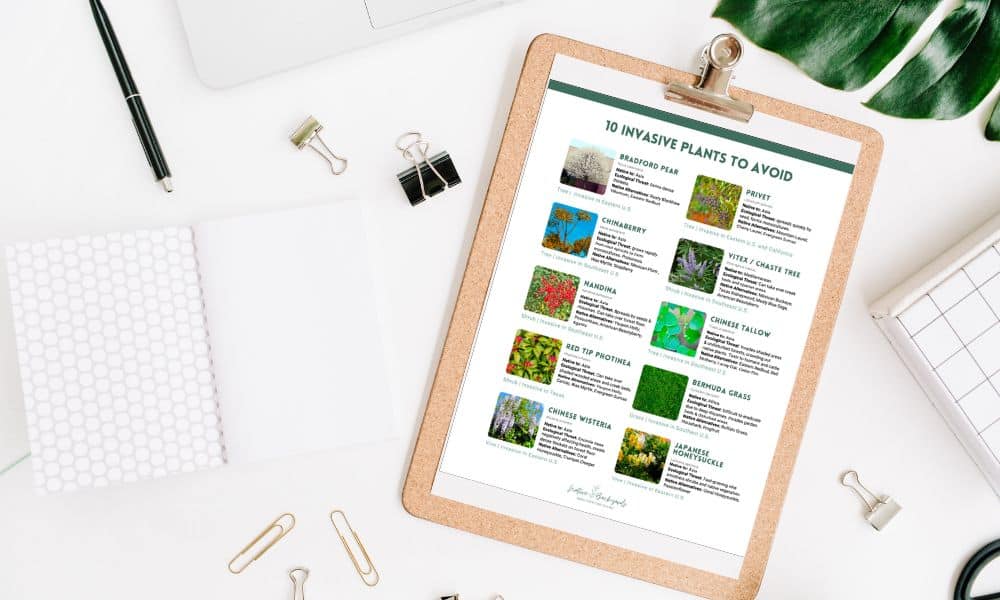
5 Reasons You Don’t Want Nandina in Your Yard
I had nandina in our yard for 7 years and enjoyed the look of it without knowing anything about it! So don’t stress if you have it in your yard.
However, if you are considering buying nandina for the first time, these reasons may encourage you to opt for something else!
1. Nandina is considered an invasive species in the United States
An invasive plant is one that has escaped from cultivation (such as your landscaping or garden), and has started growing where it wasn’t meant to grow.
Nandina invades forested areas
Nandina can be found growing in forested areas throughout the southern United States. Birds and other animals can disperse the berries causing it to grow in the wild.
In my own backyard, I have witnessed nandina’s ability to spread outside the area that it was planted. Our backyard backs up against a natural green belt, and I found it growing out there under a tree. Likely from a bird spreading its berries:
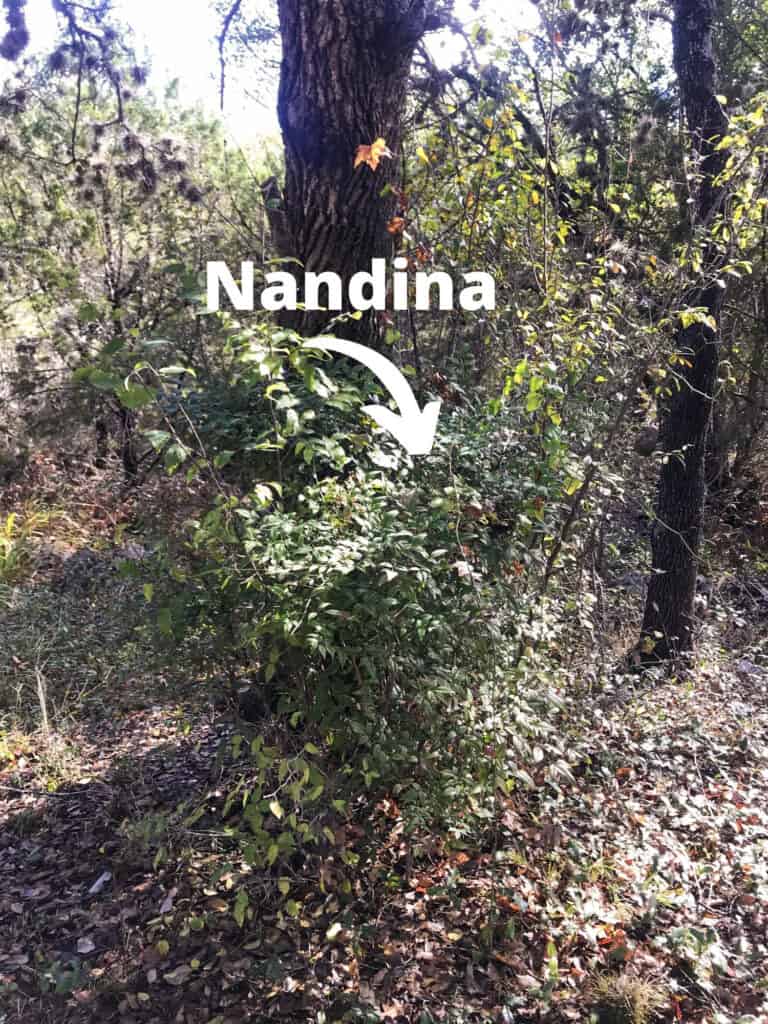
Dense thickets can crowd out native plants
Why is it so bad to have nandina in natural areas? It can form dense thickets called “monocultures” that crowd out native plants.
It leads to an overall decrease in biodiversity and fewer native plants. You can see how densely nandina can grow from my own yard. It took over the landscaped area:
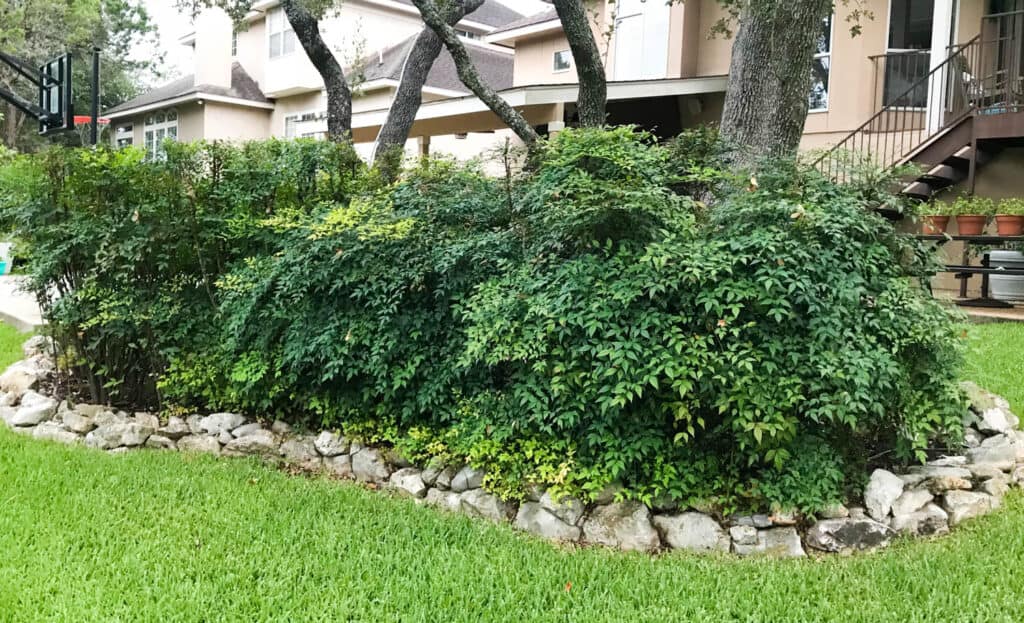
Certain states like Texas, Florida and Maryland have designated nandina as an invasive species. However, they are often still sold at nurseries. In Maryland, there are warning labels on the plants!
2. The berries can be toxic to birds and pets
I have to admit, I loved the berries on these shrubs. I would often clip them and add them to flower arrangements, and I loved the burst of color they provided in the middle of the winter. But then I read that the berries contain cyanide and have the potential to kill birds if eaten in large quantities. While birds and pets tend to avoid these berries, it is another reason for choosing a different plant for your garden.
Berries contain cyanide
Birds will only eat the berries when they’ve exhausted other food sources. While there have only been a handful of documented instances of bird deaths from nandina, I didn’t want to take the risk. Especially since my bushes directly surrounded my bird bath!
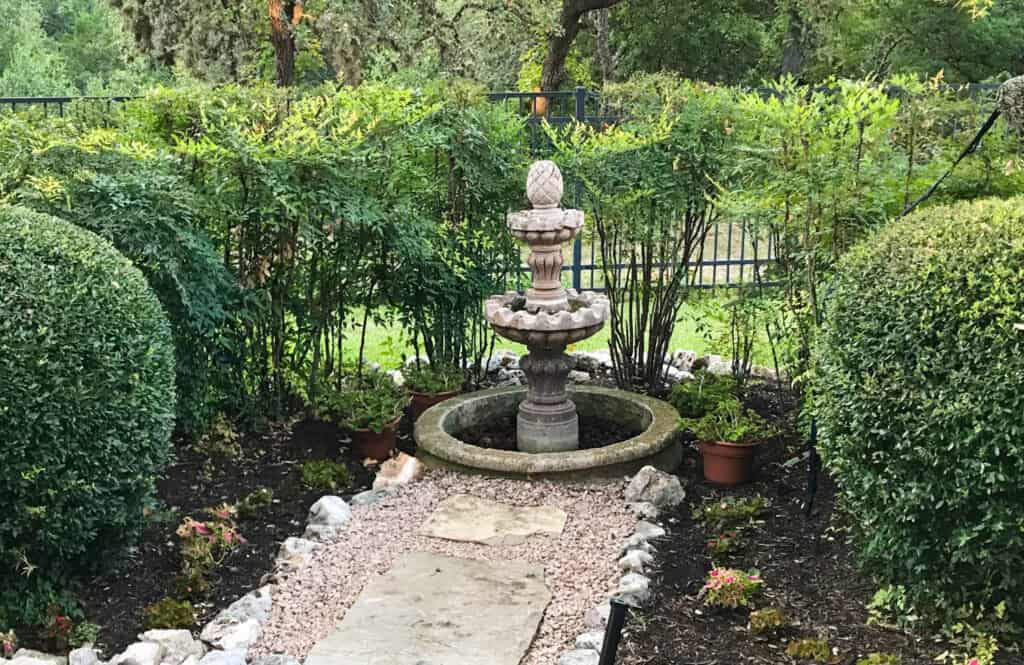
If you are a pet owner, nandina may not be the best choice for your yard. According to the ASPCA, the plant is toxic to cats and dogs. While it is unlikely they could die from eating the berries, it could make them sick.
Clipping the berries can help
If you have nandina and don’t want to remove it, one thing you can do is clip of the flowers in the summer before they produce berries. Or if you miss the flowering period, clip off the berries!
3. Nandina offers few local ecosystem benefits
One of the main criteria I now use when choosing plants for my yard is the benefits they provide for the local ecosystem. This can include nectar and food sources for pollinators and other wildlife. But some of the most important plants ecologically are those that serve as host plants to caterpillars. You can read why this is so important in my Top 6 Benefits of Native Plants.
This non-native does not serve as a host plant
According to Doug Tallamy, author of Nature’s Best Hope, some plants such as oak trees serve as host plants for hundreds of species of insects, however nandina serves as a host species for ZERO species here in the US. Its benefits to insects and other wildlife is very limited, so why not put another plant in its place!
4. There are better native plant options
The good news is that there are other great options to Nandina. If you are looking for a similar evergreen plant, try the native Yaupon Holly. The female plants produce red berries.
I recommend using the Wildflower.org native plant database to find native evergreen shrubs for your area!
Finally, if you have your heart set on Nandina, you can find cultivars that are sterile and don’t produce berries or spread by rhizomes.
5. Once you have Nandina, it is hard to get rid of it!
I had a landscaper help remove all our Nandina shrubs four months ago. He did his best to break up and remove as many of the roots as he could. However I’m still digging up new growth every couple weeks to keep it at bay.
Nandina spreads underground through rhizomes and any fragmented root and sprout a new plant! It takes determination and persistence to get rid of it for good. You can see how it can easily become invasive in natural areas. Here is some popping up in my landscaping:
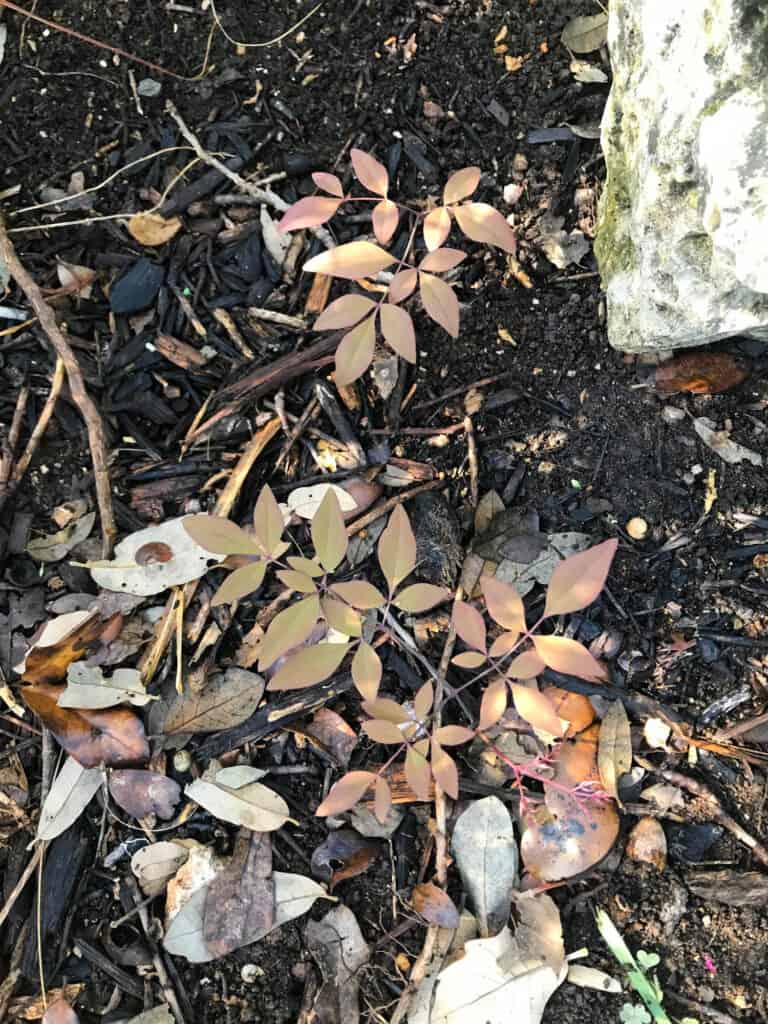
Pin this to help spread the word!
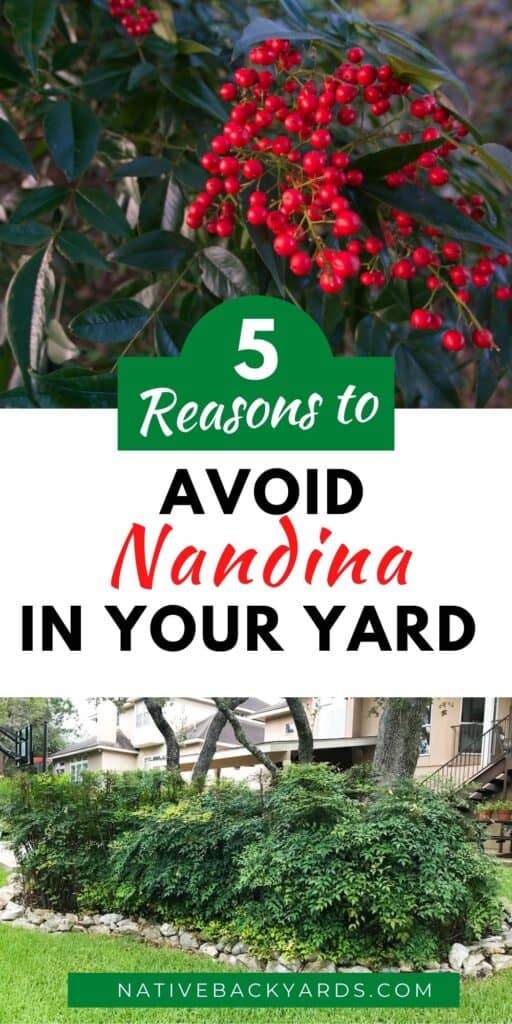
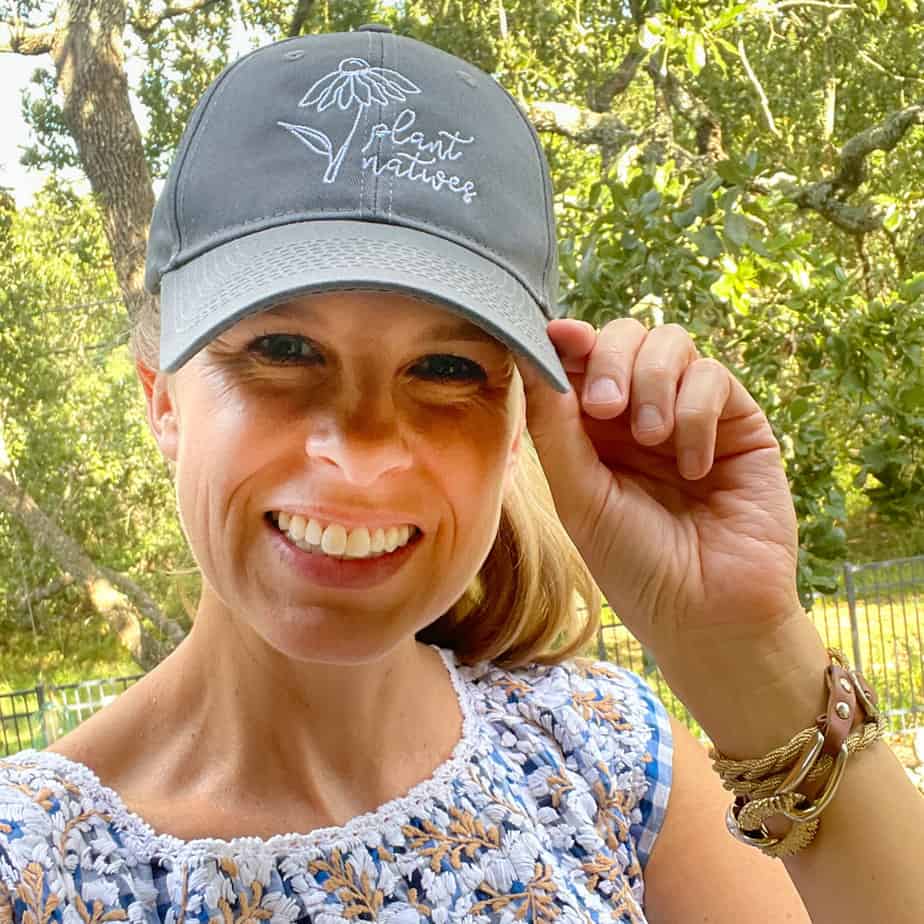
Welcome to Native Backyards! I’m Haeley from San Antonio, Texas, and I want to help you grow more native plants.
I have seen firsthand how the right plants can bring your yard to life with butterflies, bees, and birds. I’ve transformed my yard with Texas natives and I’m excited to share what I’ve learned with you.
Join my newsletter here! – each week I’ll send you helpful tips to make your native plant garden a reality!
Want to learn more about me and my garden? Check out my About page!

Would it be better to plant in a large pot. We just purchased a nandina plant and can’t take it back and don’t want to destroy it.
Hi Mark – thanks for your question! Yes, putting it in a large pot would definitely help prevent the spread of the plant through underground runners. If you are concerned about the berries being eaten or spread by birds, you can always clip those off when they first appear too. Hope that helps!
Mark, not if it is the sort that will produce berries, as it will still do this even in a container and birds will eat and spread them. And they likely won’t produce enough berries in a confined space for the amount required to kill a bird. Pots will, however, prevent spread from the root system. If you have a fruiting variety you can remove the flowers or berries and just enjoy the foliage though. It won’t likely produce a large amount of them, so this should be an easy task. But look at your plant tag if you still have it, or search the name. Several variety are non-invasive. And of these, a few a small and make great container companions. Just look of nandina companion plants for some good ideas! Good luck
Hi Mark
You should destroy it and replace it with a native plant. You are basically keeping a plant alive that is deadly to all living creatures
I live in Maryland and Mom lived in PA. We loved our Nandina, especially in the fall and winter when the berries and leaves turn red.
We purchased an old home in southwestern Arkansas that had been vacant for some time. Nandina, spiderwort, and wisteria had taken over – even to the point of hiding old appliances, bicycles and much more. We have fought all three of these plants without success. We did start digging up nandinas and planting them on a steep slope that was dangerous to mow. It actually looks very nice there. I would caution others to stay away from these three plants.
Thanks for sharing your experience, Sherry. I agree, once you have these plants they are very tough to eradicate. We also have a wisteria vine from a previous owner that we have cut and treated multiple times over the years and it continues to return. You are right, the best thing is to not buy them in the first place if you can!
I’ve always lived in North and South Carolina. Nandinas do spread, I have several varieties, red and white berries. Our emus liked the berries, I’ve never noticed any other animals attracted to them. We clip and add to arrangements as the berries seem to stay attached a long time after cutting. Never had a problem keeping the shrubs where they were wanted. I’m a lazy gardener and have been able to keep mine under control.
Wisteria has been extremely invasive, climbing any available vertical object. It can pull down trees, power lines, crawl into spaces in buildings. You can almost watch it grow. It has been really difficult to get rid of and ward it off. It’s beautiful when it blooms…… this plant isn’t for the lazy gardener, it requires almost daily attention.
Two other plants we’ve had difficulty with have been ivy- can kill your trees, will crawl into your attic and damage the mortar between your bricks on its way. Mint or peppermint- spreads better than crabgrass. Don’t let it out of pots :). Smells really good and fresh when you break or pinch, it will take over a garden if it can- in our area.
Thanks for your note! I know firsthand how hard Wisteria is to control as well. My husband spent years trying to kill a single Wisteria vine along our fence. I have heard English ivy can be very difficult to control as well.
Thank you so much for providing this information! A landscaper we just hired had recommended Nandina, but now we will absolutely be choosing another option. Appreciate you!
I hope you are able to find a great native alternative!
Haha! Clearly that landscaper has never had to remove it-it is a nightmare! Do not plant this plant. I repeat-do not plant this plant. It is the Bain of my existence! I can’t get it to go away.
I was very surprised to read all the negative comments about nandina being invasive. Maybe that only applies to sone regions of the country? We had a beautiful nandina near our entry for 38 years (until we moved). We had to trim it a few times a year to keep the height down, but it never spread. At all. I took horticulture classes years ago and there was no mention of it spreading. I am in the Pacific NW.
Hi Marcia, you are correct. Currently it is invasive in the Southern US. Here’s a link to a map that shows where it has escaped cultivation: https://www.invasiveplantatlas.org/subject.html?sub=3057.
I also live in the PNW and have had a cluster of nandina planted in one area for 45 years. I has been super easy to care for and keep in bounds. It really has not spread at all and if I want to thin it I just pull it up and the rhizomes come right up. I also have never seen berries on it but I do sometimes see blooms. I bought it more for the thick screen it would provide in one area. It also is only about 5 feet tall and I have never trimmed it down. It is planted between two of my three Dawn Redwoods. There usually are small wrens that make use of the closely spaced stems by building hidden nests. I have checked and it is not on any of the invasive species lists I have found for my area. Talk about invasive, holly is terrible to maintain and then all the seedlings from the berries plus when the berries start to ferment in the late winter, they can be deadly for the robins who love to eat them. And then there is English ivy, something that is on every invasive list. I have some in my garden I fight all the time. It was introduced from my neighbors yard. But in the parks and forests, it grows up the trees and rambles all over everything and creates what naturalists call ivy deserts.
.
We live in South Carolina and planted two dozen nandina plants seven years ago. Now they are 8-10 ft tall. We Love them and haven’t had any problems with spreading. The bumble bees thrive on the white flowers all summer. Haven’t found any dead birds, and we have 4 bird feeders and four birdbaths 30 ft away. Our five dogs and three cats don’t have any interest in them.
Hi Lori! I’m glad you haven’t had any problems with birds or your pets eating the berries. So far thankfully there have been only isolated documented instances of bird deaths. Nandina can spread to natural areas by wildlife dispersing its seeds so it can be hard to know if and where our plants are contributing to spread. Here is a map of areas in South Carolina where there have been documented instances of it escaping cultivation. It is listed by the South Carolina Exotic Pest Plant Council as a “Significant Threat”. https://www.eddmaps.org/distribution/uscounty.cfm?sub=3057.
THANK YOU, I HAVE AT LEAST 40 PLANTS ON MY PROPERTY. NOT A MINUTE OF PROBLEM.
Totally agree James –
Maybe where you live, but in Arkansas nothing eats the berries.
I think you are right that birds tend to avoid the berries. They are not their first choice. It does still spread in Arkansas. It is listed here as one of the most common and damaging invasive species at Host Springs National Park: https://www.nps.gov/hosp/learn/nature/invasive-species.htm
I live in central NC and have had 6 nandina bushes for over 17 years. They grow taller, but have never spread. These are non-berry producing nandinas. My questions is this: Is the plant still toxic to pets/birds?
Hi Traci, my apologies for the delayed response to your nandina question! It sounds like you have the sterile variety of nandina which is great. From what I’ve read, it is just the berries that can be toxic if eaten, so your plants should be totally fine for pets and birds.
I have nandinas in my front and back yard and have had no problems with them however I have had a lot of problems with yaupons and Asian jasmine being invasive. My yaupons even spread under landscape cloth. If you cut one stem 3 or 4 will come up. How do I get rid of these two invaders?
I have found cardboard and mulch to effective at smothering roots of my Asian Jasmine. I believer cardboard works better than landscape fabric and you can use several layers for even thicker protection. See more info here: https://nativebackyards.com/prevent-weeds-in-flower-beds/
I think i’ve had nandina bushes in my yard for…about 20 years so they live a very long time and are very hardy, that said, i live in a city so im not as concerned about these plants spreading into native areas. Ive also had many cats and dogs in that span of years, while the pets have never shown interest in the berries neither they or birds have ever gotten sick from these bushes. So i would think unless a animal is going ham on them, there really isnt a concern. It’s more likely that you’d need to worry about having nandinas around children.
Thank you so much for your article on Nandinas…. the Heavenly Bamboo kind… which spread in my garden via runners under landscape material! We moved into this house and thought those plants were so beautiful, lush and lacy looking and yes, quite heavenly! And then I started seeing their babies sprout up EVERWHERE! Starting to remove the landscape material exposed a highway of runners from each of the 5 large nandinas! I haven’t had any deaths of birds, not sure how I would know that, and this summer the bees LOVED the white blossoms! I am hopeful that they were not harmed! Saying all of this I have seen it pop up in my forested area and must remove it immediately before the nandinas highway constructs itself there. My dwarf nandinas do not propagate like this. I will be trying to remove these threats as time goes by.
Thank you for your article! I live in Northeastern Alabama and it is considered invasive here and still sold in our Lowes’s nursery!
Just acquired it. its potted. insightful read
Is flirt, Nandina invasive?
Hi Rebecca, it looks like Flirt Nandina is a sterile cultivar of Nandina, so it won’t spread by seed.
Hi. I’ve had a nandina domestica for a long time, it has stayed at just over 1 m in height and hasn’t spread at all. It is so beautiful I’ve just got another. I have had nesting blue-tits for over 30 years too, they ignore it. Suggest it is not harmful if your climate is cool ?!?!? Where ? WATFORD, ENGLAND !
Yes, it is invasive primarily in the Southeast United States.
Friend gave me a Fire power nandina in a pot. Live in the Pacific Northwest Should I plant it?
Hi Nicki,
Thanks for your question! You’re in luck – the Firepower cultivar is sterile and won’t produce berries that cause its spread outside your yard. Nandina is also not currently invasive in the Pacific Northwest. It is primarily a problem in the Southeast. So you can plant it without worrying, and just surround it with lots of native Pacific Northwest plants to attract the pollinators and birds. 😊
what about harm to the precious bees? [email protected]
and I did have a dead bird, cause unknown, in the back. many new nandinas growing all around the original in Forest Glen, a neighborhood of Silver Spring, MD
I don’t think the Nandina harms bees. It can provide some nectar to honey bees while it is in bloom. However the best way to support our native bees, is to plant native plants, as some of them are specialist pollinators and rely on specific native plants!
My mother’s Nandina, 20 miles inland from the N central Texas Gulf Coast, has not reseeded – OR spread in 55 years. She has never ever known seeding or spreading to be an issue there at all.
I live in the Pacific NW – and thou we have our full share of invasive species – Nandinas are definitely not one of them. They stay in their space beautifully.
I can hardly believe they are invasive! I’ve had 3 of the shrubs in my front yard for 3 years and they are still the same starter size I planted! I was hoping I would have a full hedge by now, at least 4 feet high. I’m about to replace the smallest one that has stayed at 1′ all this time.